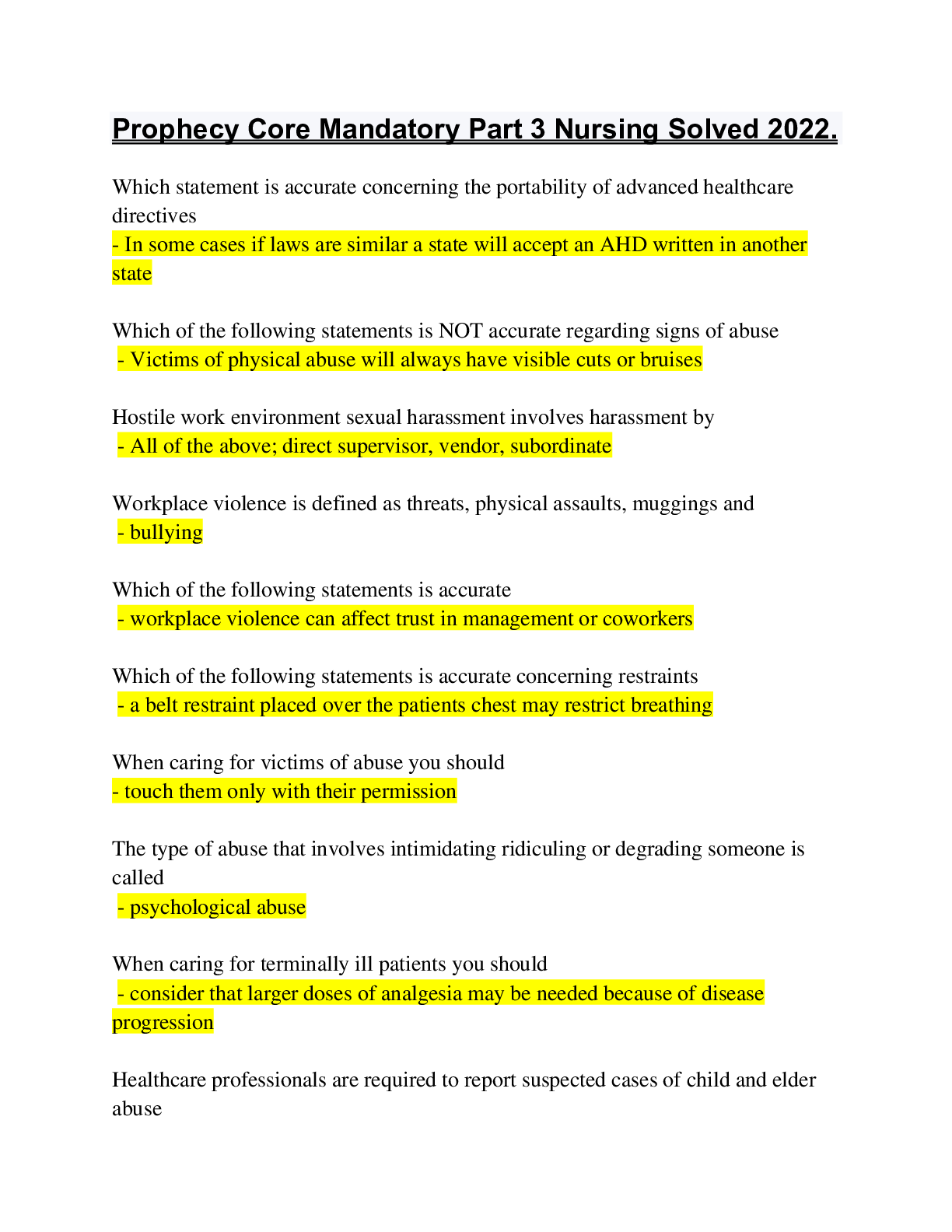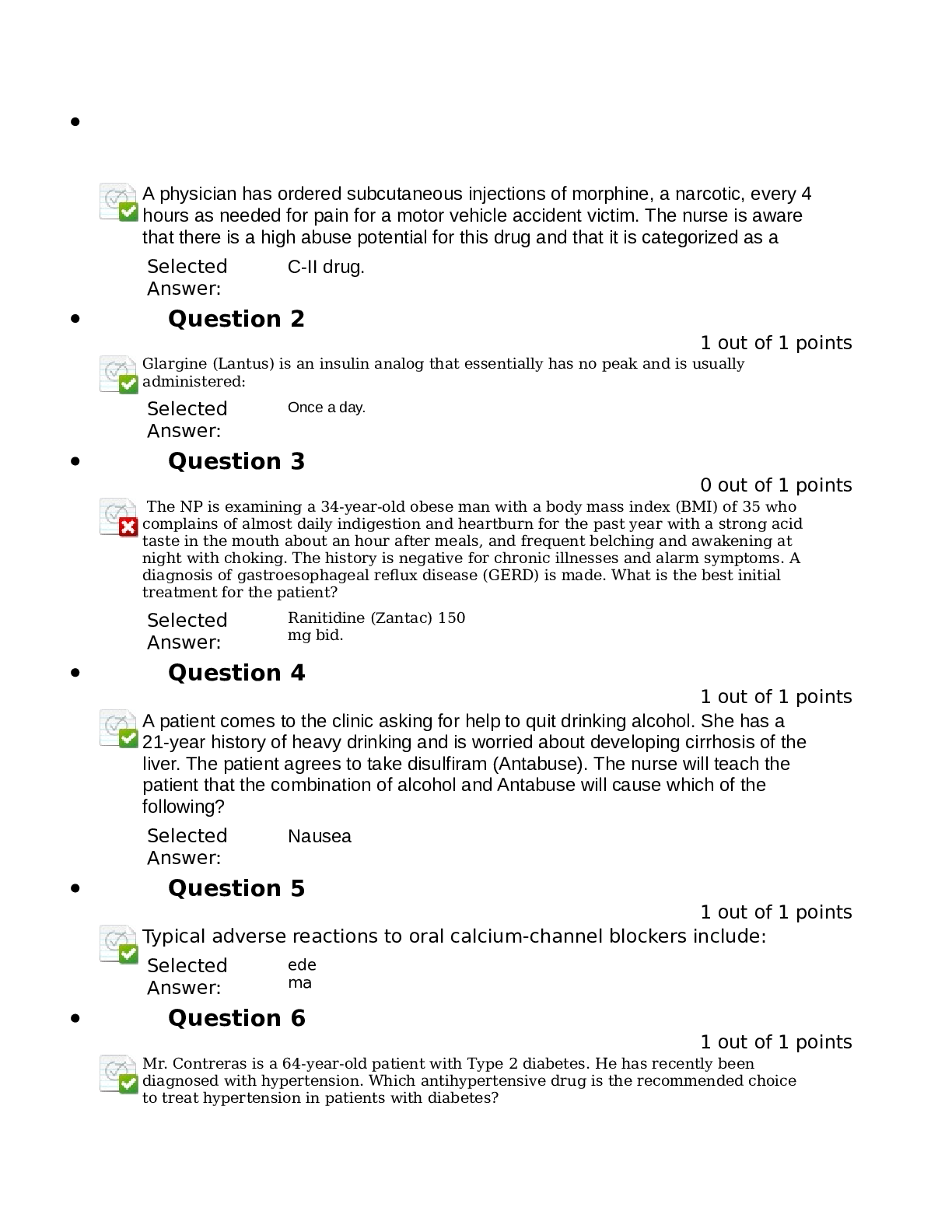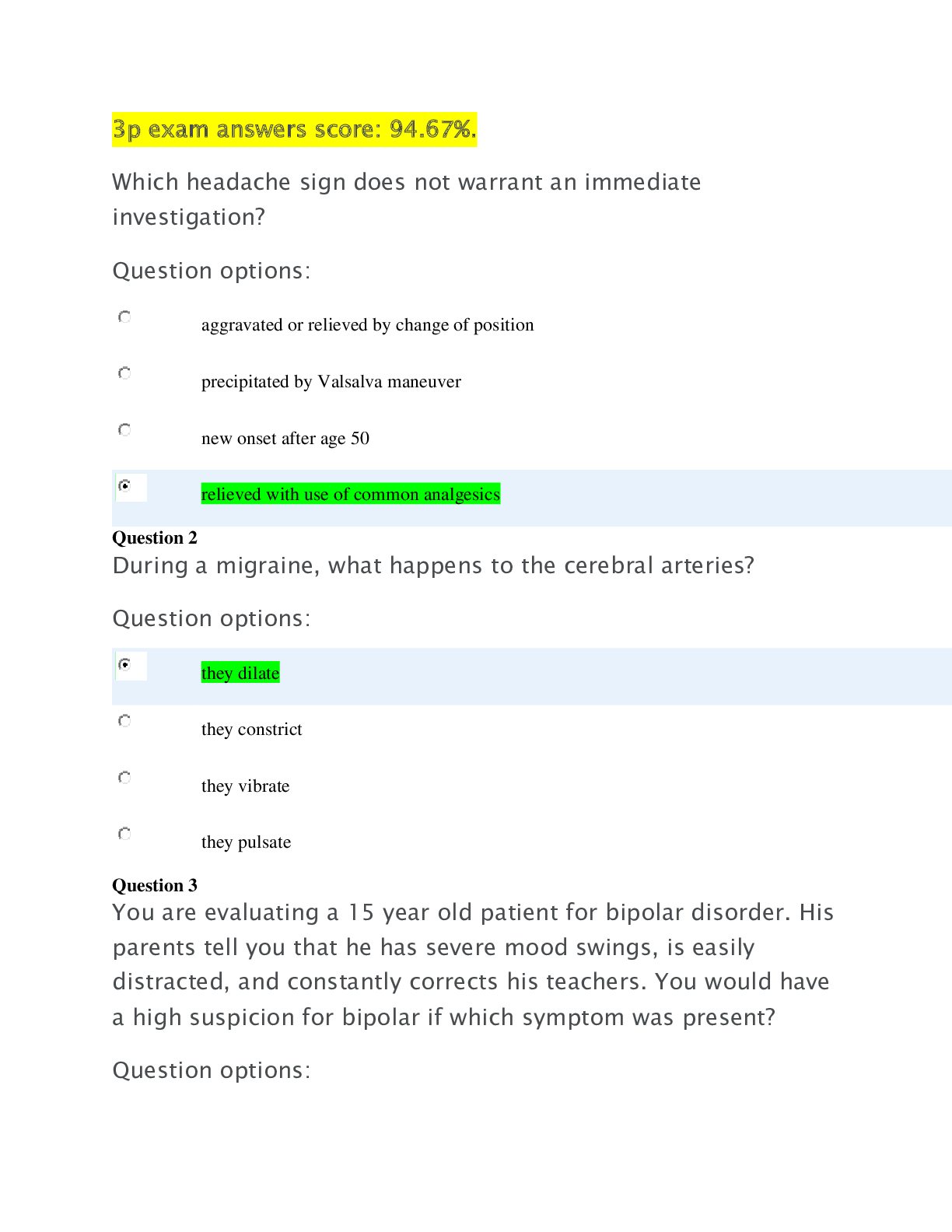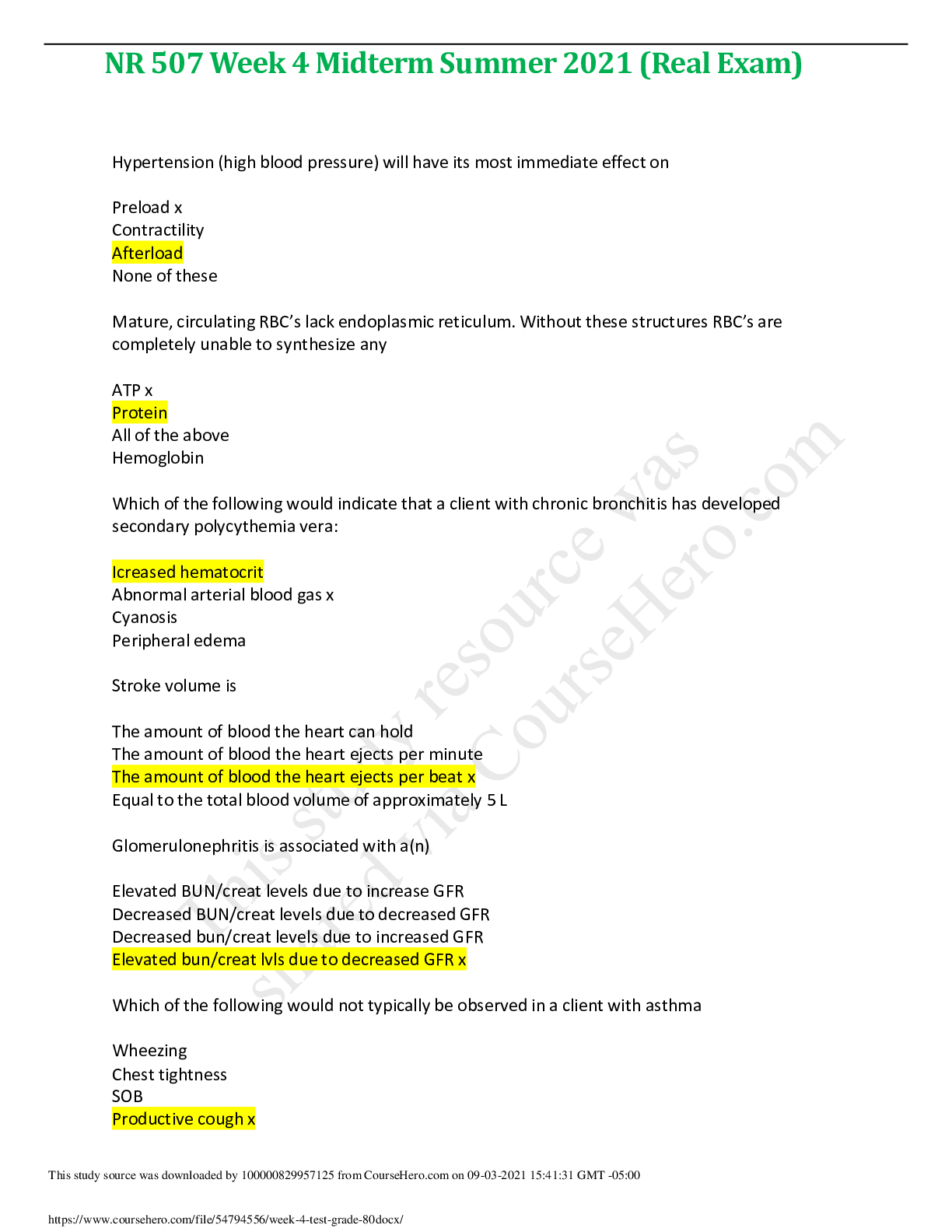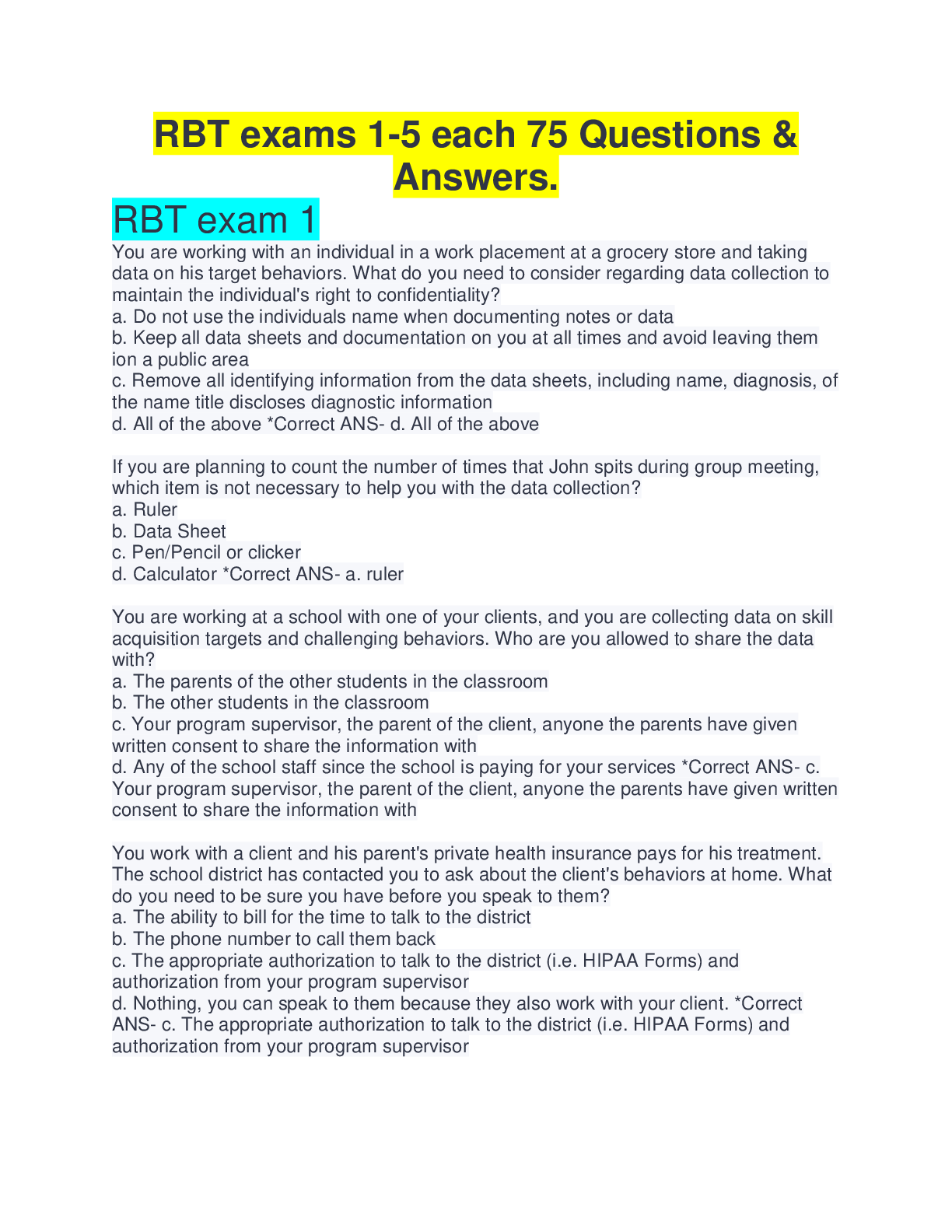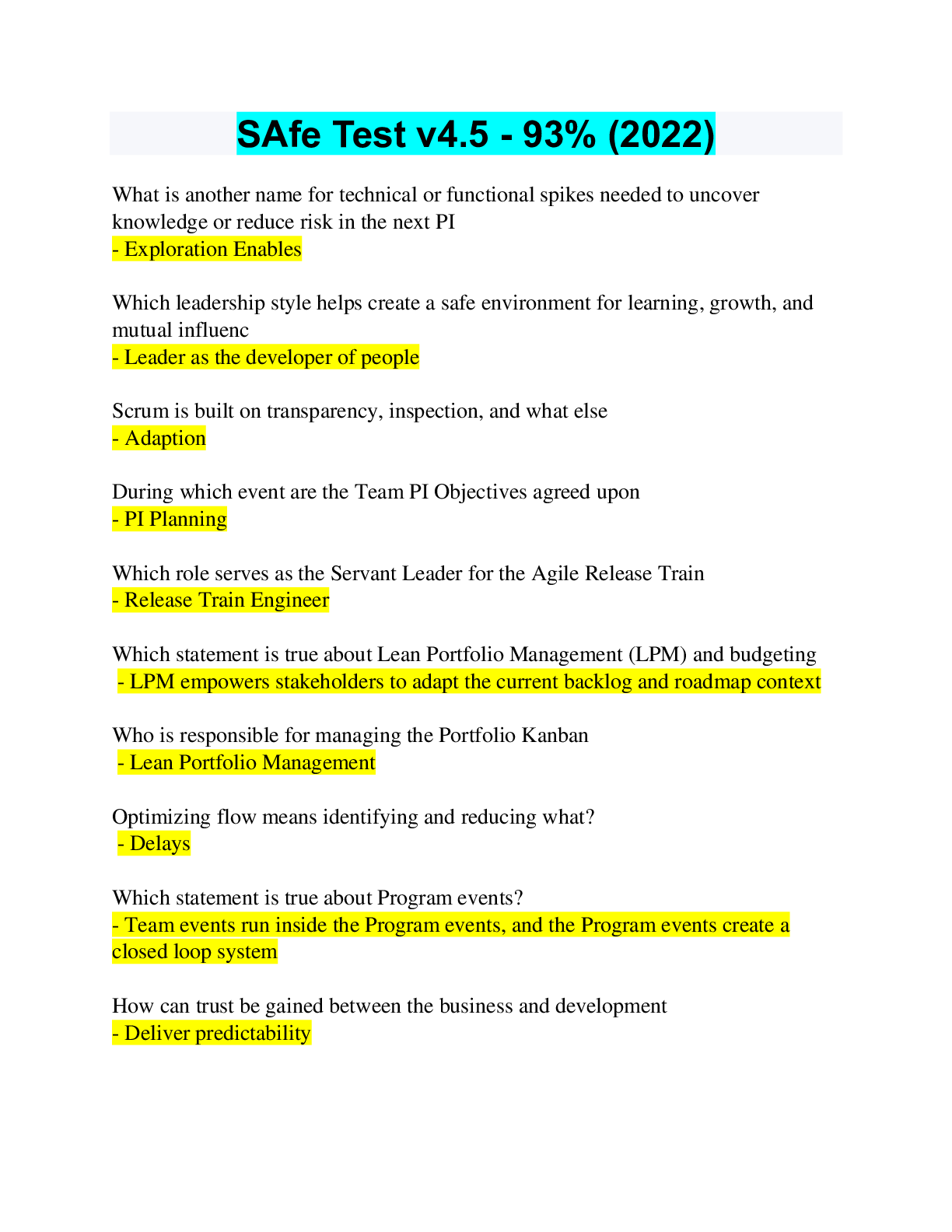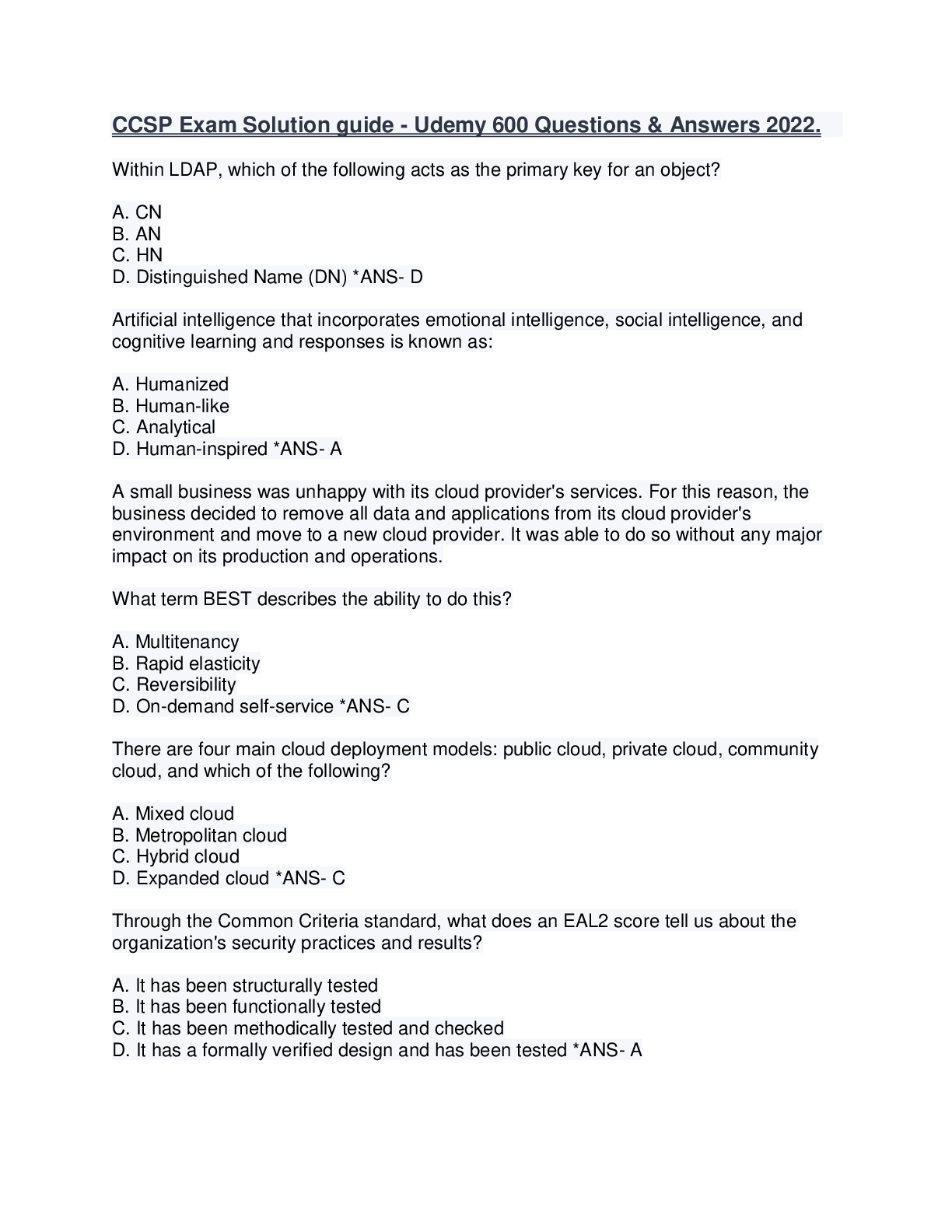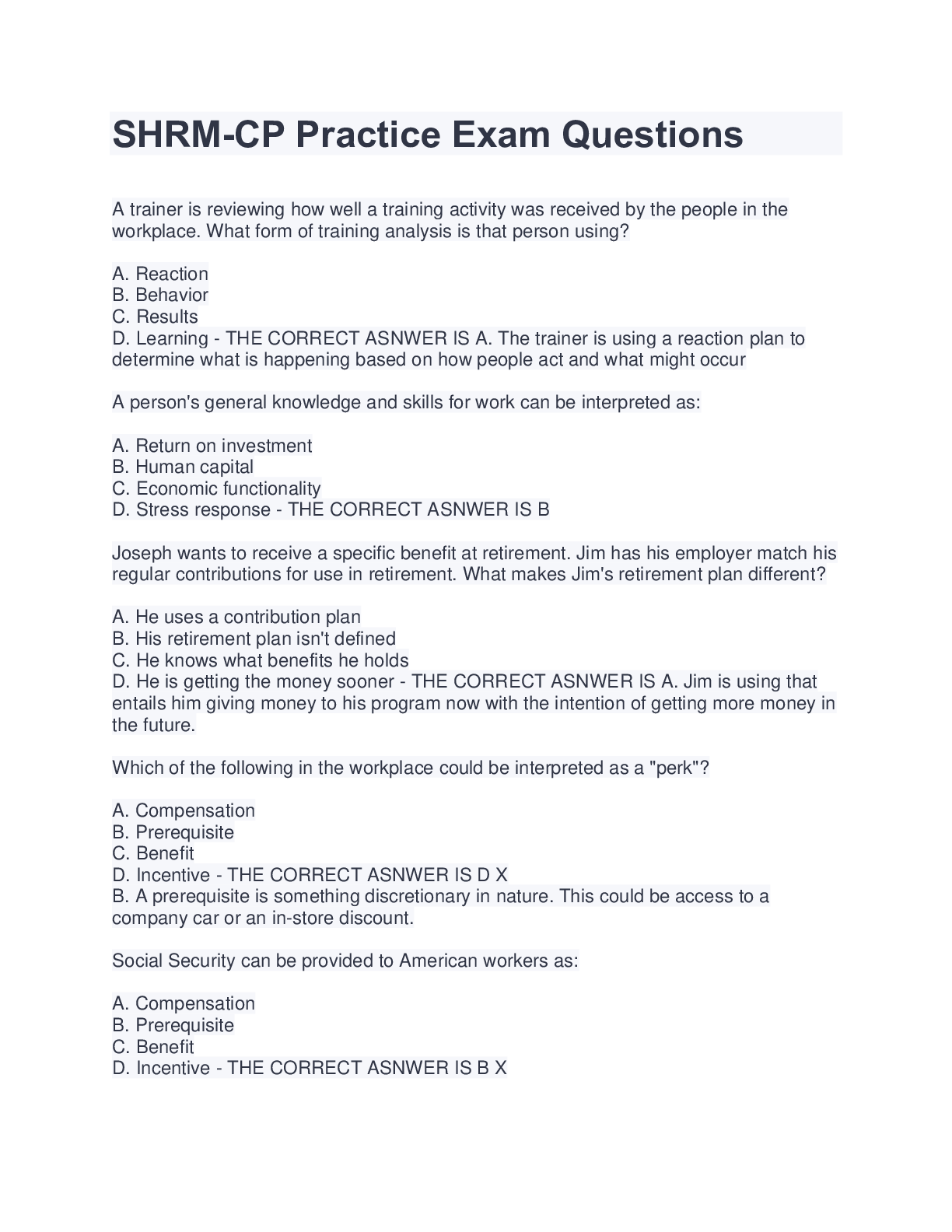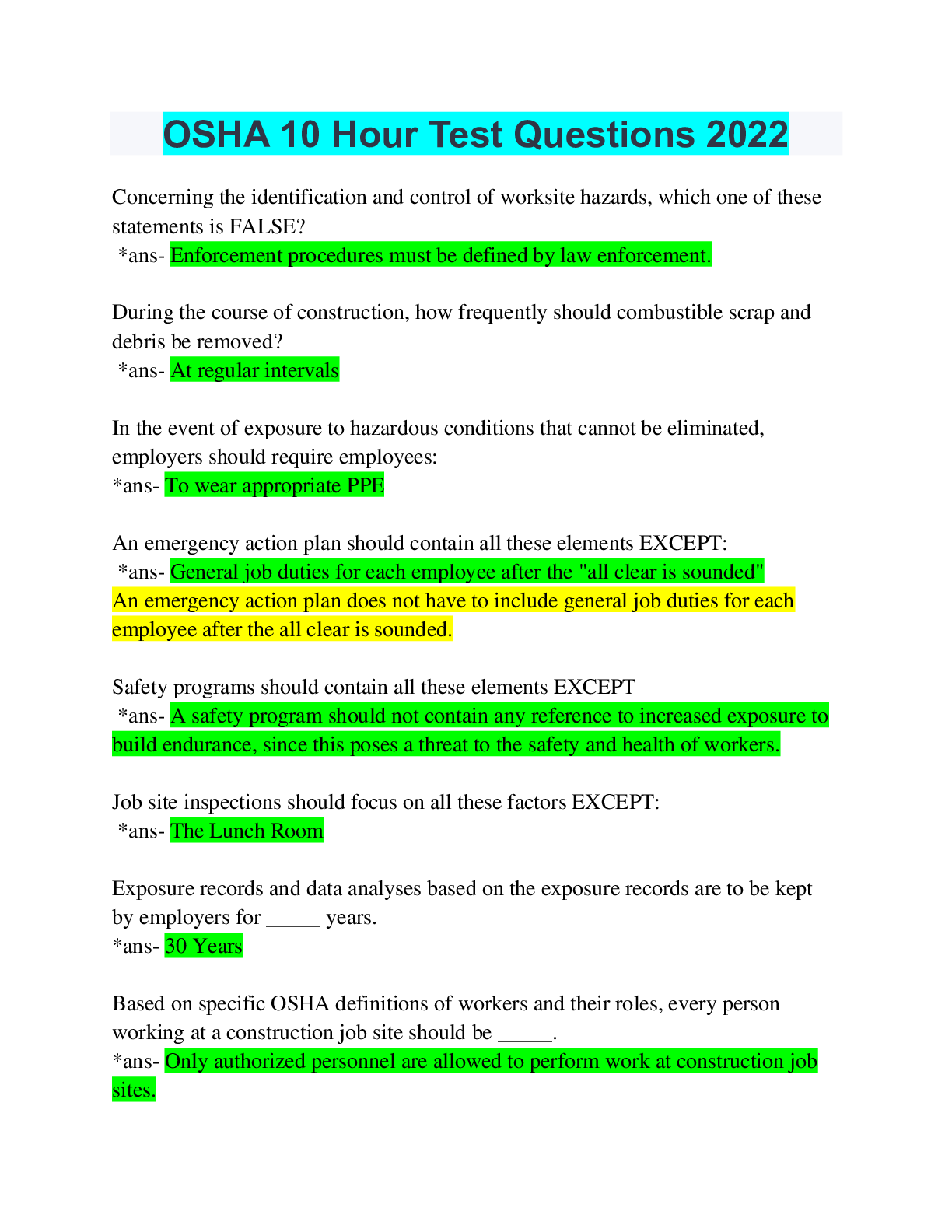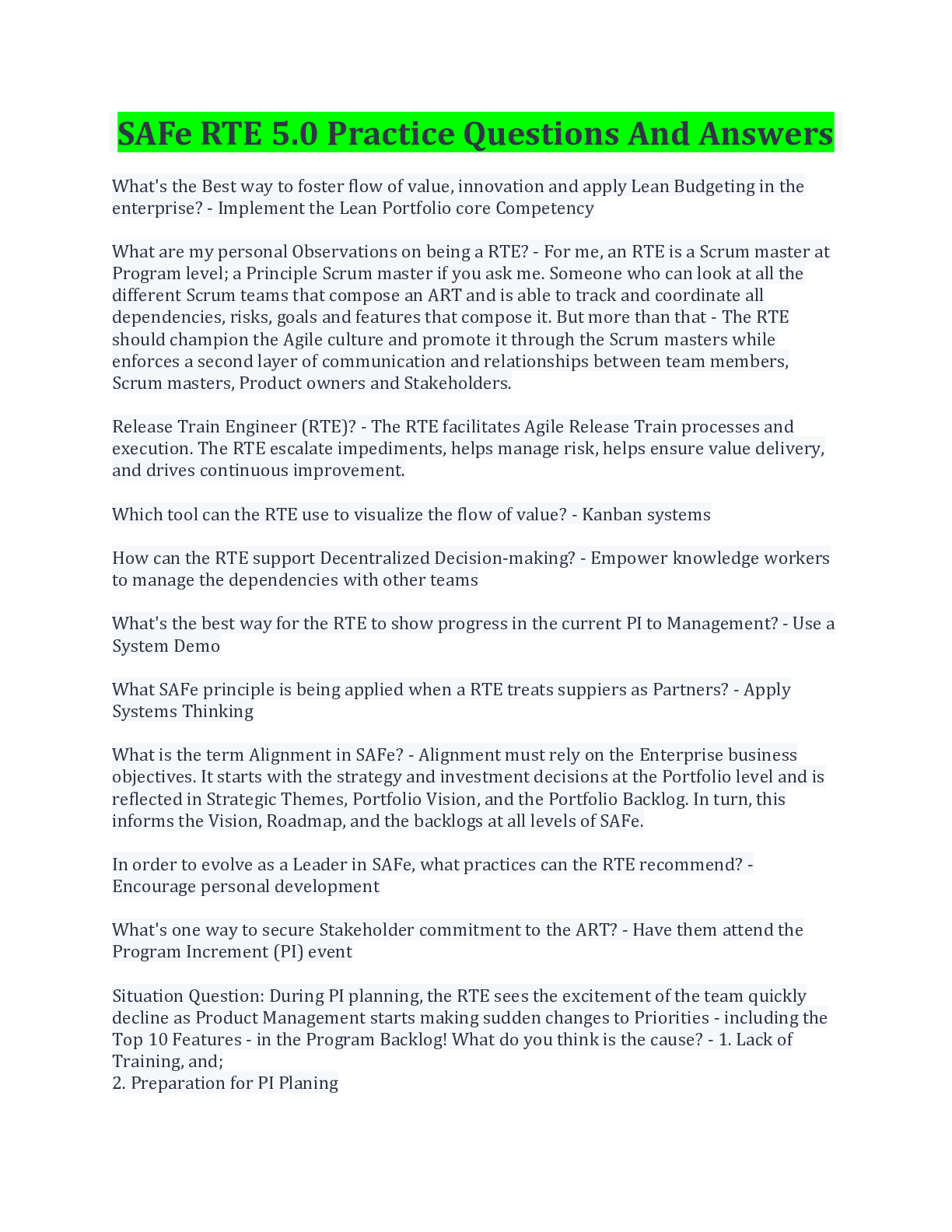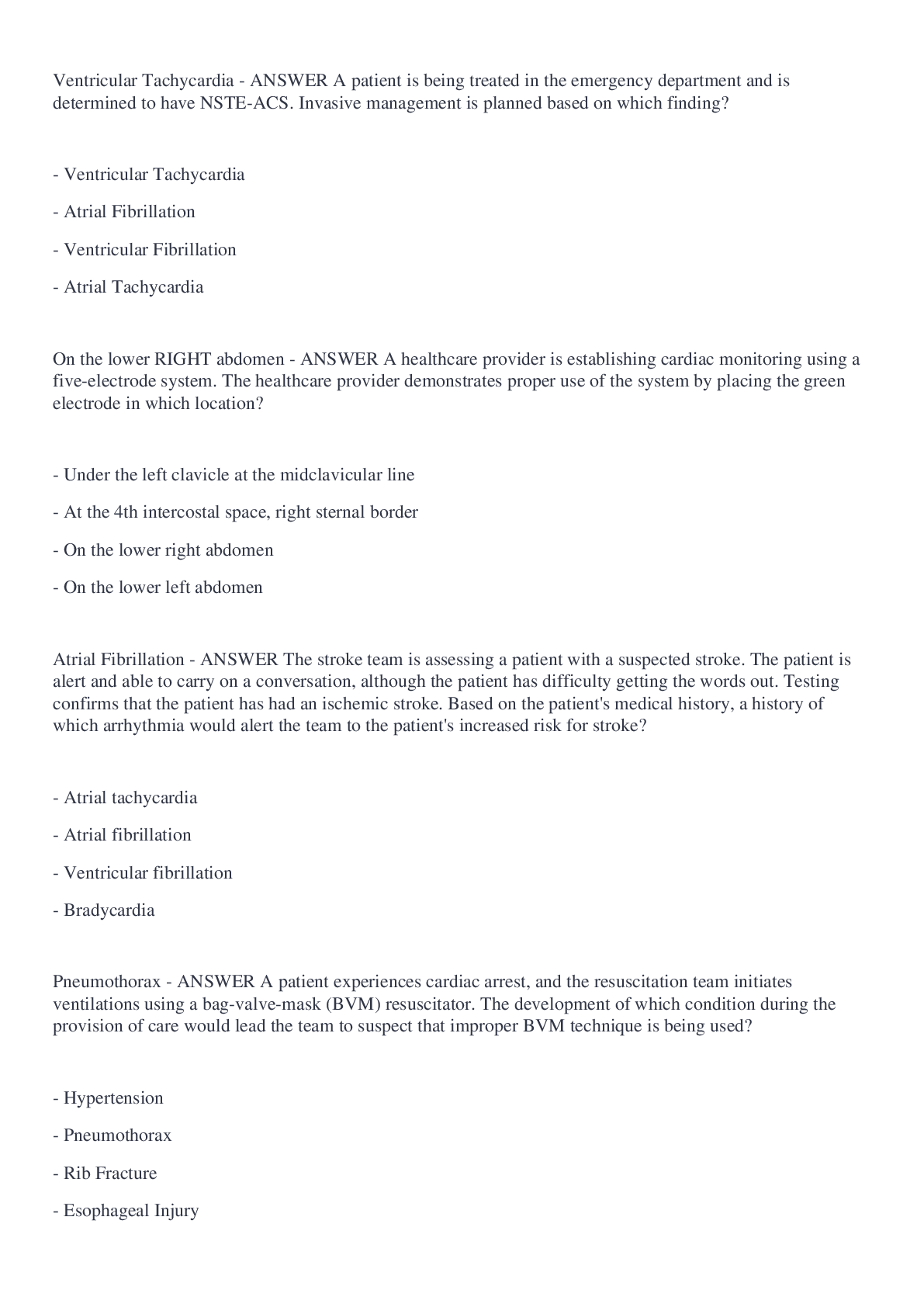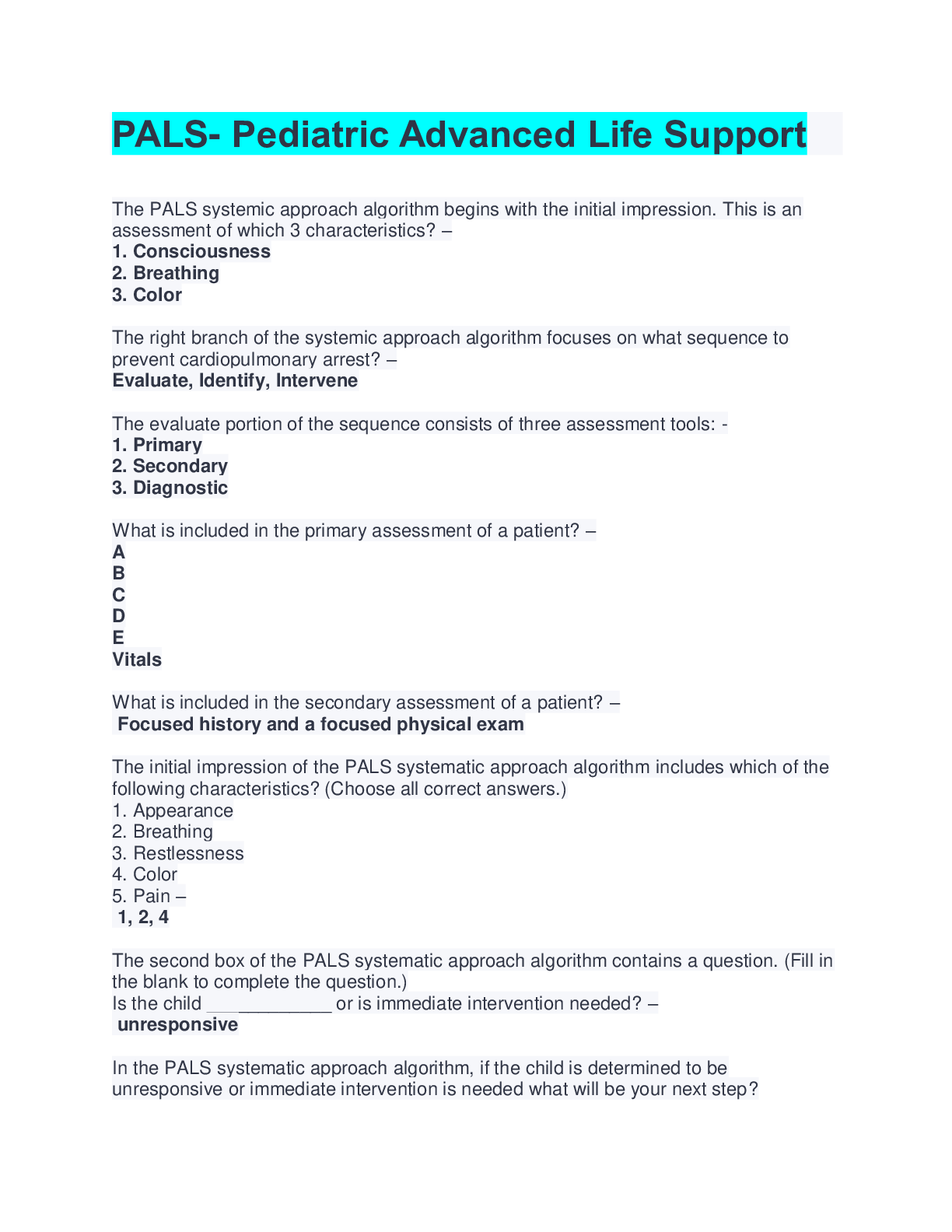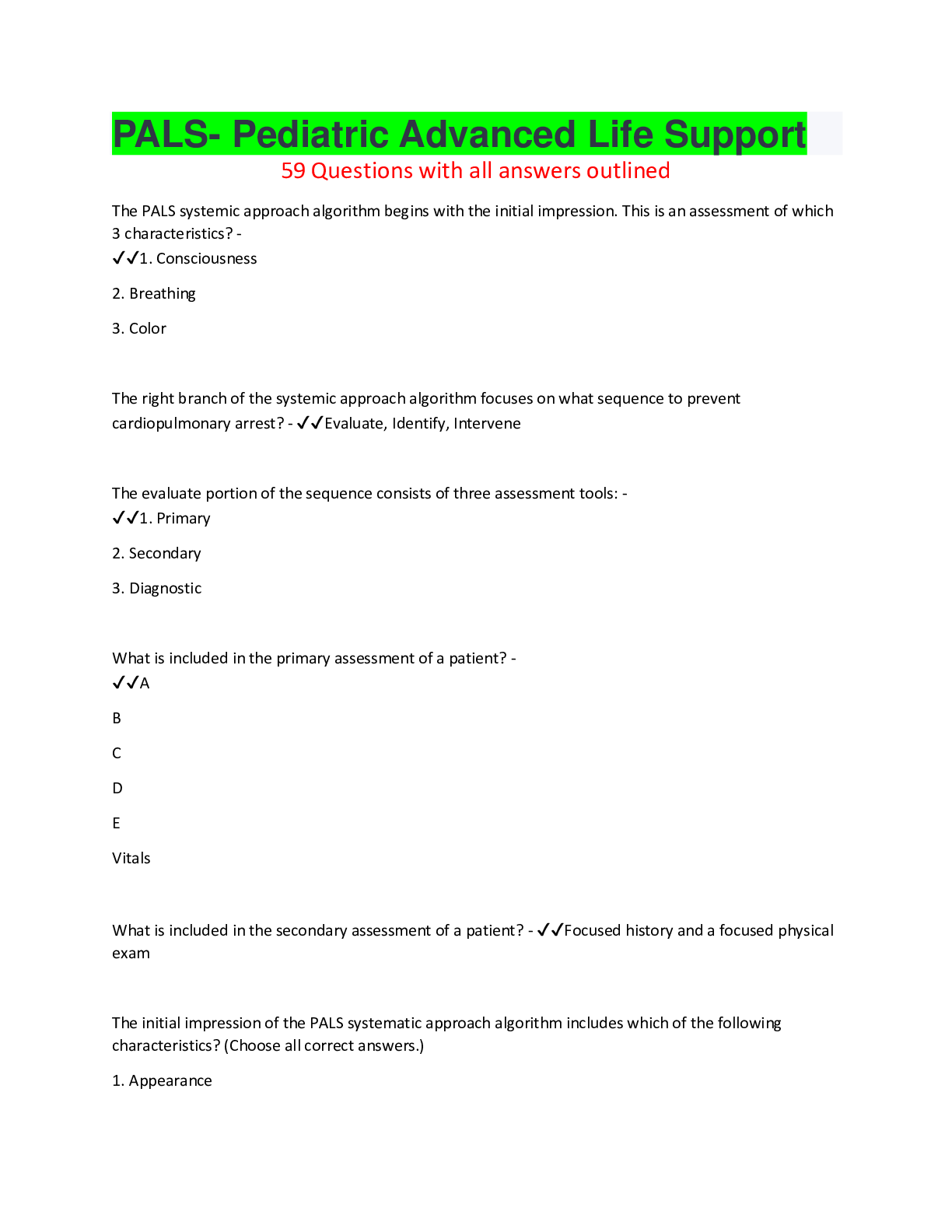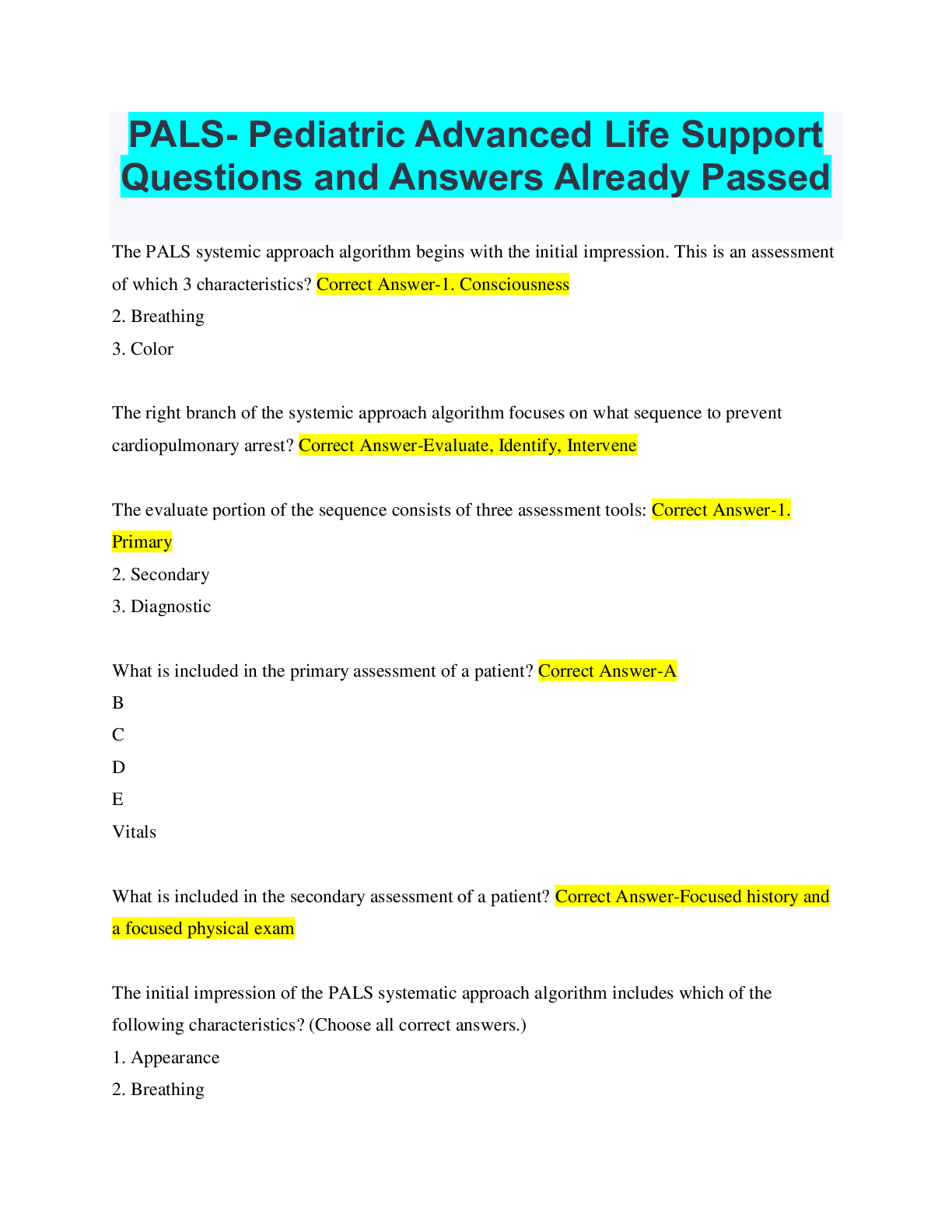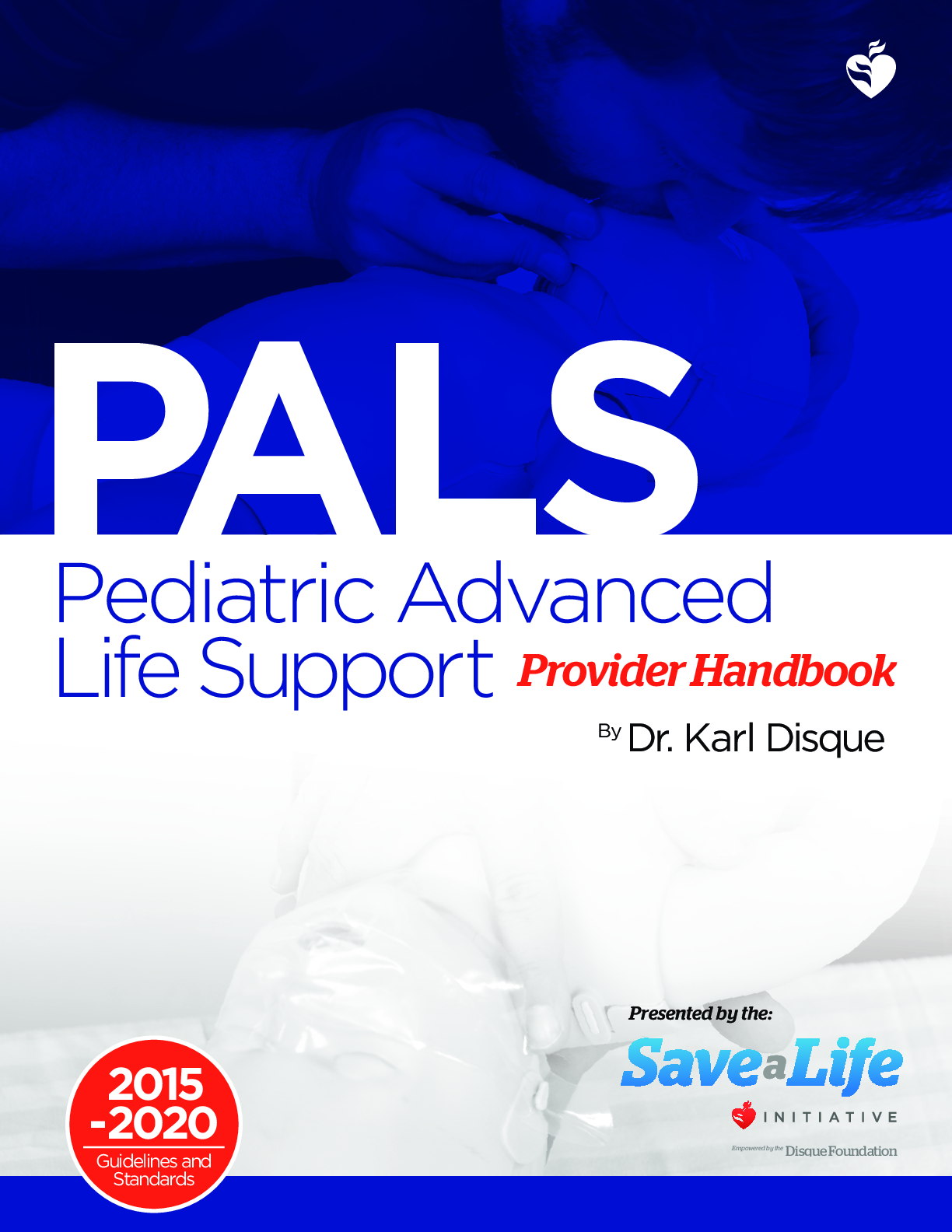AHA Pediatric Advanced Life Support 2021 Exam / PALS 2021 Exam (answered)
Document Content and Description Below
PALS 2021 Exam (answered) 1. A 6 month old infant is unresponsive. You begin checking for breathing at the same time you check for the infants pulse. Which is the maximum time you should spend whe... n trying to simultaneously check for breathing and palpate the infants pulse before starting CPR? a. 10 seconds b. 15 seconds c. 20 seconds d. 1 min 2. A 4 year old child is brought to the emergency department for seizures. The seizures stopped a few minutes ago, but the child continues to have slow and irregular respirations. Which condition is most consistent with your assessment? A. Vascular resistance B. Pulse rate C. Lung compliance D. Disordered Control of breathing 3. An 8 year (or 18 months or toddler) old child is brought to the emergency department with a 2 day history of (vomiting and diarrhea.) lethargy and polyuria. The child has new onset rapid, deep, and labored breathing. Which diagnostic test should you order first? A. Arterial blood gas B. Serum potassium concentration C. Glucose D. A 12-lead ECG 4. After rectal administration of diazepam, an 8 year old boy with a history of seizures is no unresponsive to painful stimuli. His respirations are shallow, at a rate of 10/min. His Oxygen saturation is 94% on 2L of NC oxygen. On examination, the child is snoring with poor chest rise and poor air entry bilaterally. What action should you take next? 5. After rectal administration of diazepam, an 8 year old boy with a history of seizures is no unresponsive to painful stimuli. His respirations are shallow, at a rate of 10/min. His Oxygen saturation is 94% on 2L of NC oxygen. On examination, the child is snoring with poor chest rise and poor air entry bilaterally. After repositioning the patient and you insert an Oral airway, the patient continues to deteriorate. What next step is the most appropriate? 6. A 6 year old child is found unresponsive, not breathing, and without a pulse. one health care worker leaves to activate the emergency response system and get the resuscitation equipment. You and another healthcare provider immediatly begin CPR. Which compression to ventilation ratio do you use? a. 15:2 b. 30:2 c. 15:1 d. 30:1 7. In post resuscitation management after cardiac arrest, extra care should be taken to avoid repercussion injury. what should the ideal oxygen saturation range most likely be? A. 92% to 100% B. 92% to 99% C. 94% to 99% D. 94% to 100% 8. A 3 year old child is in cardiac arrest, and high quality CPR is in progress. You are the team leader. The first rhythm check reveals the rhythm shown here. Defibrillation is attempted with a shock dose of 2 J/kg. after administration of the shock, what should you say to you team members? A. Resume CPR, beginning with chest compressions B. Check for a pulse C. Analyze the rhythm D. Administer epinephrine 9. A 4 year old child in cardiac arrest is brought to the emergency department by ambulance. High quality CPR is being performed. The cardiac monitor displays the rhythm strip shown here. The estimated weight of the child is 20 kg. What dose range should you use for the initial defibrillation? a. 4-6 J/kg b. 6-8 J/kg c. 0.5-2 J/kg d. 2-4 J/kg 10. A 4 year old child in cardiac arrest is brought to the emergency department by ambulance. High quality CPR is being performed. The cardiac monitor displays the rhythm strip shown here. The estimated weight of the child is 20 kg. As the team leader, how many joules do you tell your team member to use to perform initial Defib? a. 100 Joules b. 40 Joules c. 140 Joules d. 10 Joules 11. You are the team leader during a pediatric resuscitation attempt. which action is an element of high quality CPR? A. A depth of compressions of about one fourth the anterior-posterior depth of the chest B. A compression rate of 80/min C. Pulse checks performed once per minute D. Allowing the chest wall to recoil completely between compressions 12. You are caring for a 3 month old boy with a 2 day history of fever, vomiting and diarrhea. His parents state that he has been sleeping much more. His HR is 190/min, temp is 38.3 degrees C (101 F) blood pressure is 59/29 mmHg, Resp rate is 70/min and shallow, and oxygen sat is 94% on 100% oxygen. His capillary refills time is 4-5 seconds, and he has mottled, cool extremities. The infant weighs 6 Kg. Which assessment finding indicates that the infant is in hypotensive shock? 13. You are caring for a 3 month old boy with a 2 day history of fever, vomiting and diarrhea. His parents state that he has been sleeping much more. His HR is 190/min, temp is 38.3 degrees C (101 F) blood pressure is 59/29 mmHg, Resp rate is 70/min and shallow, and oxygen sat is 94% on 100% oxygen. His capillary refills time is 4-5 seconds, and he has mottled, cool extremities. The infant weighs 6 Kg. On the basis of this infants presentation, which type of shock does this infant have? A. Septic shock B. Hypovolemic shock C. Significant bradycardia D. Cardiogenic shock 14. You are caring for a 3 month old boy with a 2 day history of fever, vomiting and diarrhea. His parents state that he has been sleeping much more. His HR is 190/min, temp is 38.3 degrees C (101 F) blood pressure is 59/29 mmHg, Resp rate is 70/min and shallow, and oxygen sat is 94% on 100% oxygen. His capillary refills time is 4-5 seconds, and he has mottled, cool extremities. The infant weighs 6 Kg. You have decided that this infant Needs fluid resuscitation. How much fluid should you administer? A. 10 mL/kg normal saline B. 20 mL/kg of 5% dextrose and 0.2% sodium chloride C. 20 mL/kg normal saline D. 10 mL/kg lactated Ringer's 15. A 2 week old infant is being evaluated for irritability and poor feeding. His BP is 55/40 mmHg, and cap refill time is 5 seconds. Which statement best describes your assessment of this infants BP? A. Hypotensive B. Normal C. Hypertensive D. Compensated 16. A team member is unable to perform an assigned task because it is beyond the team members scope of practice. Which action should the team member take? 17. Which abnormality helps identify children with acute respiratory distress caused by lung tissue disease? A. Decreased oxygen saturation B. Stridor C. Normal respiratory rate D. Decreased respiratory effort or crackles 18. Which condition in a child would IO access most likely be attempted before vascular access? or In which of the following situations would a IO be used? a. extremity with a crushed injury b. extremity with a previous unsuccessful IO attempt c. extremity with signs of infection d. extremity with a slow cap refill 19. You respond to an infant who is unresponsive, in not breathing, and doe not have a pulse. You shout for nearby help, but no one arrives. What action should you take next? 20. An unresponsive 9 year old boy is pale and cool to the touch his blood pressure is 70/45 mmHg, heart rate is 190/min and respiratory rate is 12/min. The SpO2 is not detectable Cap refill time is 5 seconds. An IV is in place. The cardiac monitor displays the rhythm shown here. What rhythm is seen on the patient cardiac monitor? 21. An unresponsive 9 year old boy is pale and cool to the touch his blood pressure is 70/45 mmHg, heart rate is 190/min and respiratory rate is 12/min. The SpO2 is not detectable Cap refill time is 5 seconds. An IV is in place. The cardiac monitor displays the rhythm shown here. If initial treatment is unavailable or delayed, which intervention is indicated? a. 20 mL/kg of isotonic crystalloid b. High quality CPR c. Defibrillation d. Syncronized cardioversion. 22. You are performing the airway component of the primary assessment. Which finding would lead you to conclude that the child has an upper airway obstruction? Answer - inspiratory stridor 23. A 3 year old child is having difficulty breathing. Which finding would most likely lead you to suspect an upper airway obstruction in this child? 24. You are caring for patients in the emergency department. Which 2 year old child requires immediate intervention? 25. You are evaluating a 10 year old child who is febrile and tachycardia. The Childs cap refill times 5 seconds. which parameter will determine if the child is in compensated shock? 26. A 3 year old child is brought to the emergency department by his mother. Which is a normal finding for a 3 year old child? 27. An unresponsive 9 year old boy was given a dose of rectal valium by his caretaker for a prolonged seizure. His BP is 80/40 mmHg, HR is 45/min, respiratory rate is 6/min, and SpO2 is 60% no room air. He is unresponsive and cyanotic. The cardiac monitor displays the rhythm shown here. Which rhythm is most consistent with this patients presentation and ECG findings? A. Ventricular escape rhythm B. Ventricular tachycardia C. Pulseless electrical activity D. Sinus bradycardia 28. An unresponsive 9 year old boy was given a dose of rectal valium by his caretaker for a prolonged seizure. His BP is 80/40 mmHg, HR is 45/min, respiratory rate is 6/min, and SpO2 is 60% no room air. He is unresponsive and cyanotic. The cardiac monitor displays the rhythm shown here. What is your next action? 29. A 10 year old child is being evaluated for a head ache. Which is a normal finding for this 10 year old child? 30. A 5 year old child is brought to the emergency department by ambulance after being involved in a MVC. You are using the primary assessment to evaluate the child. When assessing the Childs neurological status, you note that he has spontaneous eye opening, is fully oriented, and is able to follow command. How would you document this Childs AVPU pediatric response scale finding? Answer 31. A 6 month old infant is being evaluated for bradycardia. Which is the most likely cause of bradycardia? 32. You are caring for a 5 year old boy with a 4 day history of high fever and cough. He is having increasing lethargy, grunting, and sleepiness. Now he is difficult to arouse and is unresponsive to voice commands. His O2 sat is 72% on room air and 89% when on a NRB O2 mask. He has shallow respirations, with a respiratory rate of 38/min. Auscultation of the lungs reveals bilateral crackles. Which assessment finding is consistent with respiratory failure in this child? 33. You are caring for a 5 year old boy with a 4 day history of high fever and cough. He is having increasing lethargy, grunting, and sleepiness. Now he is difficult to arouse and is unresponsive to voice commands. His O2 sat is 72% on room air and 89% when on a NRB O2 mask. He has shallow respirations, with a respiratory rate of 38/min. Auscultation of the lungs reveals bilateral crackles. Which medication would be most appropriate? 34. What ratio for compressions to breaths should be used for 1 rescuer infant CPR 35. An 8 year old child is brought to the ED by ambulance after being involved in a MVC. Which finding would suggest that immediate intervention is needed? 36. You are Caring for a 9 month old girl who has increased work of breathing, a fever, and a cough. On assessment, you find an alert infant with stridor and retractions. The infants SpO2 is 94% On auscultation, the lungs are clear bilaterally. Which is the most likely cause of this infants respiratory distress? a. peripheral lung disease b. Lower airway obstruction c. upper airway obstruction 37. You are Caring for a 9 month old girl who has increased work of breathing, a fever, and a cough. On assessment, you find an alert infant with stridor and retractions. The infants SpO2 is 94% On auscultation, the lungs are clear bilaterally. Which medication should you administer first? a. Nebulized albuterol b. IV ceftrianxone c. nebulized Epinephrine d. bethamethesone 38. Which condition is characterized by a prolonged excretory phase and wheezing? A. Disordered control of breathing B. Hypovolemic shock C. Lower airway obstruction D. Upper airway obstruction Answer - c. Lower airway obstruction 39. During a resuscitation attempt, the team leader asks you to administer an initial dose of Epinephrine at 0.1 mg/kg to be given IO. How should you respond? A. Administer the drug as ordered B. Administer 0.01 mg/kg of epinephrine C. Respectfully ask the team leader to clarify the dose D. Refuse to administer the drug 40. You are caring for a 12 year old girl with acute lymphoblastic leukemia. She is responsive but she does not feel well and appears to be flushed. Her Temp is 39 degrees C (102.2 F), HR is 118/min, respiratory rate is 36/min, BP is 100/40 mmHg, and oxygen sat is 96% on room air. Your assessment reveals mild increase in work of breathing and bounding pulses. The child is receiving 100% Oxygen by NRB mask.--- Laberatory studies document a lactic acidosis. On the basis of the patients clinical assessment and history. Which type of shock does this patient most likely have? 41. You are caring for a 12 year old girl with acute lymphoblastic leukemia. She is responsive but she does not feel well and appears to be flushed. Her Temp is 39 degrees C (102.2 F), HR is 118/min, respiratory rate is 36/min, BP is 100/40 mmHg, and oxygen sat is 96% on room air. Your assessment reveals mild increase in work of breathing and bounding pulses. The child is receiving 100% Oxygen by NRB mask.--- Which assessment finding is the most important in your determination of the severity of the patients condition? 42. You are caring for a 12 year old girl with acute lymphoblastic leukemia. She is responsive but she does not feel well and appears to be flushed. Her Temp is 39 degrees C (102.2 F), HR is 118/min, respiratory rate is 36/min, BP is 100/40 mmHg, and oxygen sat is 96% on room air. Your assessment reveals mild increase in work of breathing and bounding pulses. The child is receiving 100% Oxygen by NRB mask.--- Which NS bolus is most appropriate for this patient? 43. You are caring for a 12 year old girl with acute lymphoblastic leukemia. She is responsive but she does not feel well and appears to be flushed. Her Temp is 39 degrees C (102.2 F), HR is 118/min, respiratory rate is 36/min, BP is 100/40 mmHg, and oxygen sat is 96% on room air. Your assessment reveals mild increase in work of breathing and bounding pulses. The child is receiving 100% Oxygen by NRB mask.--- In edition to oxygen administration and appropriate fluid resuscitation, which additional early intervention should you provide to the patient? A. Provide 100% oxygen via a nonrebreathing mask B. Obtain IV access C. Administer dopamine D. Administer an antibiotic 44. A 3 year old boy is brought to the ED by his mother. His is lethargic, with retractions and nasal flaring. He has a respiratory rate of 70/min, with warm extremities and brisk cap refill. To which immediate life treating condition could this Childs condition most likely progress if left untreated? A. Respiratory distress B. Respiratory arrest C. Respiratory failure D. Disordered control of breathing 45. A 6 year old boy is being evaluated for difficulty breathing. Which finding would suggest this child has respiratory distress? a. O2 75% b. Respiration Rate 8 c. Decreased effort d. Audible inspiratory stridor 46. An 8 year old child is brought to the ED by his mother for difficulty breathing. He has a history of asthma and nut allergies. He's mother tells you that he recently ate a cookie at a family picnic. Which condition is most likely to be present in this child? a. upper airway obstruction b. lower airway obstruction c. lung tissue disorder 47. A 10 year old child is brought to the ED for fever and cough. You obtain an O2 sat on the child. Which oxygen saturation would indicate that immediate intervention is needed? 48. You are evaluating a 1 yer old child for respiratory distress. His HR is 168/min, and his respiratory rate has decreased from 65/min to 30/min. He now appears more lethargic and continues to have severe subcostal retractions. On the basis of your assessment, which is the most likely reason for this change in the Childs condition. A. Respiratory distress is unchanged B. Progression toward respiratory failure C. Improved respiratory status D. Neurologic impairment 49. The parents of a 7 year old child who is undergoing chemotherapy report that the child has been febrile and has not been feeling well, with recent onset of lethargy. Assessment reveals that the child is difficult to arouse and her skin color is pale. The Childs HR is 160/min, respiratory rate is 38/min, blood pressure is 76/45 mmHg, cap refill time is 5 to 6 seconds, and temp is 39.4 degrees C (103 F). IV access has been established, and blood cultures have been obtained. which action should you perform next? A. Obtain vascular access and administer 20 mL/kg of isotonic crystalloid over 30 minutes B. Obtain vascular access and administer 20 mL/kg of isotonic crystalloid over 5 to 10 minutes C. Obtain immediate blood cultures and chest x-ray D. Obtain expert consultation with an oncologist to determine the chemotherapeutic regimen 50. A 7 year old child in cardiac arrest is brought to the ED by ambulance. No palpable pulses are detected. The Childs ECG is shown here. How would you characterize this Childs rhythm? A. Ventricular escape rhythm B. Ventricular tachycardia C. Pulseless electrical activity D. Sinus bradycardia [Show More]
Last updated: 5 months ago
Preview 1 out of 9 pages
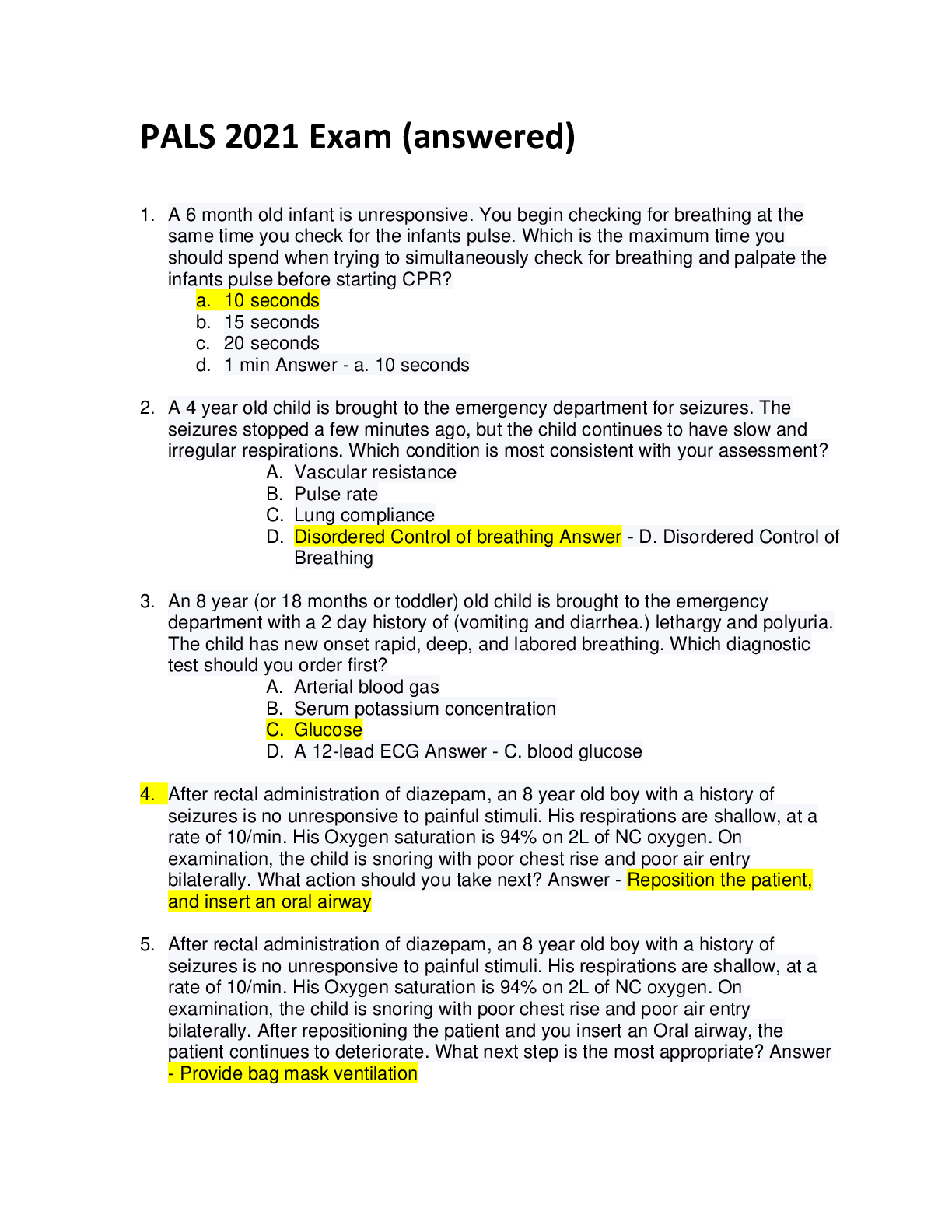
Reviews( 0 )
Document information
Connected school, study & course
About the document
Uploaded On
Feb 23, 2022
Number of pages
9
Written in
Additional information
This document has been written for:
Uploaded
Feb 23, 2022
Downloads
5
Views
562

